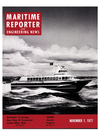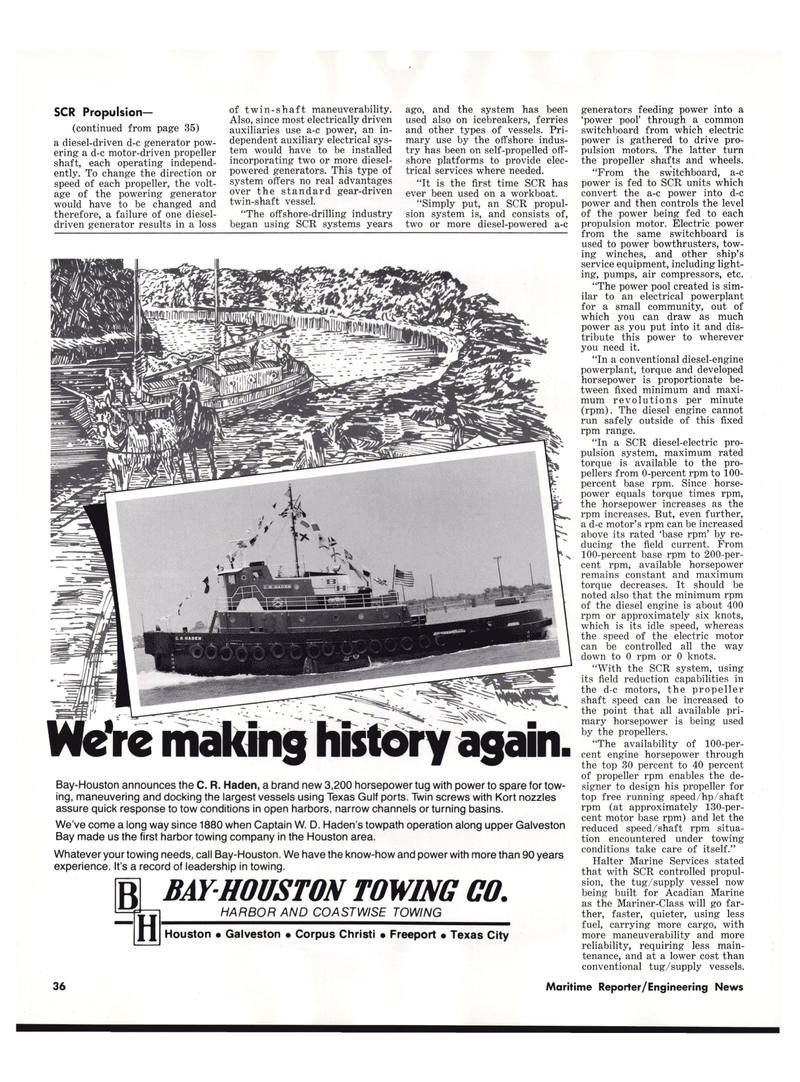
Page 36: of Maritime Reporter Magazine (November 1977)
Read this page in Pdf, Flash or Html5 edition of November 1977 Maritime Reporter Magazine
SCR Propulsion— (continued from page 35) a diesel-driven d-c generator pow- ering a d-c motor-driven propeller shaft, each operating independ- ently. To change the direction or speed of each propeller, the volt- age of the powering generator would have to be changed and therefore, a failure of one diesel- driven generator results in a loss of twin-shaft maneuverability.
Also, since most electrically driven auxiliaries use a-c power, an in- dependent auxiliary electrical sys- tem would have to be installed incorporating two or more diesel- powered generators. This type of system offers no real advantages over the standard gear-driven twin-shaft vessel. "The offshore-drilling industry began using SCR systems years ago, and the system has been used also on icebreakers, ferries and other types of vessels. Pri- mary use by the offshore indus- try has been on self-propelled off- shore platforms to provide elec- trical services where needed. "It is the first time SCR has ever been used on a workboat. "Simply put, an SCR propul- sion system is, and consists of, two or more diesel-powered a-c generators feeding power into a 'power pool' through a common switchboard from which electric power is gathered to drive pro- pulsion motors. The latter turn the propeller shafts and wheels. "From the switchboard, a-c power is fed to SCR units which convert the a-c power into d-c power and then controls the level of the power being fed to each propulsion motor. Electric power from the same switchboard is used to power bowthrusters, tow- ing winches, and other ship's service equipment, including light- ing, pumps, air compressors, etc. "The power pool created is sim- ilar to an electrical powerplant for a small community, out of which you can draw as much power as you put into it and dis- tribute this power to wherever you need it. "In a conventional diesel-engine powerplant, torque and developed horsepower is proportionate be- tween fixed minimum and maxi- mum revolutions per minute (rpm). The diesel engine cannot run safely outside of this fixed rpm range. "In a SCR diesel-electric pro- pulsion system, maximum rated torque is available to the pro- pellers from 0-percent rpm to 100- percent base rpm. Since horse- power equals torque times rpm, the horsepower increases as the rpm increases. But, even further, a d-c motor's rpm can be increased above its rated 'base rpm' by re- ducing the field current. From 100-percent base rpm to 200-per- cent rpm, available horsepower remains constant and maximum torque decreases. It should be noted also that the minimum rpm of the diesel engine is about 400 rpm or approximately six knots, which is its idle speed, whereas the speed of the electric motor can be controlled all the way down to 0 rpm or 0 knots. "With the SCR system, using its field reduction capabilities in the d-c motors, the propeller shaft speed can be increased to the point that all available pri- mary horsepower is being used by the propellers. "The availability of 100-per- cent engine horsepower through the top 30 percent to 40 percent of propeller rpm enables the de- signer to design his propeller for top free running speed/hp/shaft rpm (at approximately 130-per- cent motor base rpm) and let the reduced speed/shaft rpm situa- tion encountered under towing conditions take care of itself."
Halter Marine Services stated that with SCR controlled propul- sion, the tug/supply vessel now being built for Acadian Marine as the Mariner-Class will go far- ther, faster, quieter, using less fuel, carrying more cargo, with more maneuverability and more reliability, requiring less main- tenance, and at a lower cost than conventional tug/supply vessels. again,
Bay-Houston announces the C. R. Haden, a brand new 3,200 horsepower tug with power to spare for tow- ing, maneuvering and docking the largest vessels using Texas Gulf ports. Twin screws with Kort nozzles assure quick response to tow conditions in open harbors, narrow channels or turning basins.
We've come a long way since 1880 when Captain W. D. Haden's towpath operation along upper Galveston
Bay made us the first harbor towing company in the Houston area.
Whatever your towing needs, call Bay-Houston. We have the know-how and power with more than 90 years experience. It's a record of leadership in towing.
BL BAY HOUSTON TOWING CO.
H HARBOR AND COASTWISE TOWING Houston • Galveston • Corpus Christi • Freeport • Texas City 36 Maritime Reporter/Engineering • News

 35
35

 37
37
